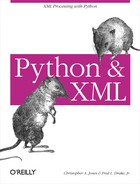Types of Conformance
As with any specification, the primary reason for the XML specification’s existence is to hold documents against it and make sure they conform to the specification. If so, then the rules within the specification can be used in reading, transforming, or applying the document. However, we must remember that XML defines two things: syntax for document instances, and a way to define new language using XML. It also tells us that we can use the former without the latter, so it must define what it means to conform to the specification in both cases.
If a document uses the XML syntax but does not depend on a specific markup language defined using the means provided by the XML recommendation, it needs to be well-formed in order to conform with XML. This is a form of conformance introduced by XML rather than inherited from SGML. On the other hand, a document that declares that it uses a specific markup language defined by a DTD is said to be valid if it is both well-formed and the elements and character data are arranged in a way that complies with the rules given by the specified Document Type Definition.
The XML specification defines a collection of text to be an XML document if it is well-formed according to the rules of the specification. The term well-formed is widely used in XML, and it refers to a document that is syntactically acceptable. For example:
<?xml version="1.0"?> <book> <title>Python and XML</title> </book>
The preceding document is well-formed. That is, beyond the
XML declaration (described in more detail in Section 2.5.6, later in this
chapter) pointing out that the document uses Version 1.0 of XML, both
the book and title elements are opened
and closed so that elements nest within each other in a strictly
hierarchical way. You can’t open a book and close a magazine.
Being well-formed is required but not sufficient to describe the concept of validity, which deals with the conformance of a document to a Document Type Definition. It’s one thing to have the structure arranged such that it is syntactically acceptable, but quite another to ensure that the information contained within the document is organized in the appropriate fashion and contains all of the necessary elements to be of use in an application or transaction.
The XML specification describes all XML processors as belonging to two classes: validating and nonvalidating. Regardless of validation, both types of processors must report violations of the specification’s well-formedness constraints; otherwise, an XML document may be impossible to parse. A validating processor must be able to report violations of the DTD to the application. This requires that a validating processor read the entire DTD, and resolve and parse any external entities (described in the next section) referenced within the DTD itself and in the document instance. In contrast, nonvalidating processors need check only the document and internal DTD subset for well-formedness. Checking that a document is well-formed does not require accessing any external entities.
Since the arrival of alternate schema languages, a third form of conformance has been described informally. A document is said to be schema valid with respect to a particular schema, regardless of the language in which the schema is expressed, if the document is well-formed and the structure of the document conforms to the specific schema using the rules defined for that specific schema language. This is a generalization of the concept of validity given by the XML recommendation; all valid documents are also schema valid for the schema defined by their DTD (though they may be invalid for other schema).
